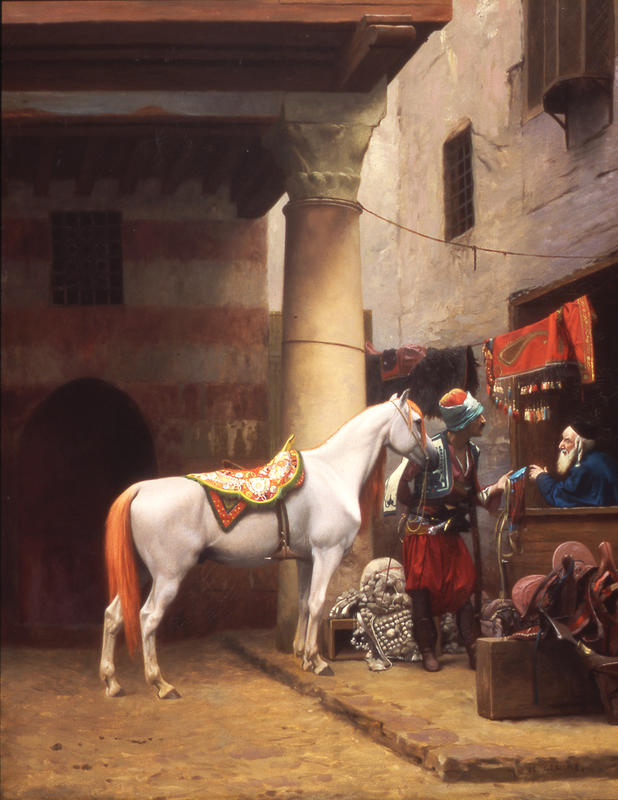More about The Saddle Bazaar, Cairo

Sr. Contributor
When Jean-Leon Gerome painted The Saddle Bazaar, Cairo around 1833, “Orientalism” was in high fashion.
In the case of Saddle Bazaar, all of the main elements are present: the architecture of the buildings, the brightly colored, detailed textiles and clothing of both the horse and the potential buyer, even the physical looks of the Turkish man and the Jewish merchant. The only figures missing are the nude or semi-nude women that were very much a part of the usual “Orientalist” art of that time.
Depending on a person’s point of view, this trend was not necessarily a bad thing in and of itself; the negative view might be the stereotyping of the individuals and their culture in the painting, whether by the clothing they wear, or the setting of the scene. Unlike some artists who painted Middle Eastern or Northern African scenes without ever seeing these places in person, Gerome actually made multiple trips to Egypt, as many as seven times between 1856 and 1880. By the time he painted Saddle Bazaar, he would have been familiar enough with the markets and urban life in Cairo.
The man doing the purchasing is a bashi-bazouk, or Turkish mercenary. Gerome had previously painted this archetype in Cafe House, Cairo (Casting Bullets), Dance of the Almeh, and in the appropriately titled Bashi-Bazouk. At the time this work was completed, the Bulgarian revolution of 1876 (also known as the April Uprising) would still be a fairly recent memory in the minds of the original viewers. The bashi-bazouk units, together with the regular Ottoman army, viciously destroyed the Bulgarian revolutionaries, which resulted in public outrage in Europe, and eventually, the re-establishment of the Bulgarian state.
Gerome was also a skilled sculptor, and the horse in the painting is based off of his sculpture Thoroughbred Horse, in the Hirshhorn Museum and Sculpture Garden. There are differences, most notably the tail, which is longer and dyed with henna in the painting. This was a common practice in areas of the world where the henna plant grew in abundance; the decoration could be for a celebration, such as a wedding or a festival. It was also used to denote the high status of an individual, which is possibly the case for our bashi-bazouk...or it could just mean he was a bad-ass.
In an inventory conducted at Gerome’s studio following his death in 1904, there were ten Oriental-style saddles, along with hats, weapons, and many other props that he used to create his fairly accurate scenes. This painting was also known as Arab Purchasing a Bridle, and has been mistakenly listed as Arab Purchasing a Bride on a few websites.
Sources
- Kip, Brint, G. (2017, July 28). Henna for horses: Ancient decorative and medicinal traditions. Kip Mistral. https://www.kipmistral.com/henna-for-horses-ancient-decorative-and-medi…
- Orientalism in Nineteenth-Century Art. Metmuseum.org. (n.d.). https://www.metmuseum.org/toah/hd/euor/hd_euor.htm.
- Sanders, P. B. (1991). The Haggin Collection. Haggin Museum.
- Skenderovic, Damir, and Christina Späti. “From Orientalism to Islamophobia: Reflections, Confirmations, and Reservations.” ReOrient 4, no. 2 (2019): 130–43. https://doi.org/10.13169/reorient.4.2.0130.
- The Saddle Bazaar, Cairo by Jean-Léon Gérôme. Artvee. (2021, August 21). https://artvee.com/dl/the-saddle-bazaar-cairo/.
- Time on canvas: Everyday moments of Egyptian life in the 1800's. Cairo Scene. (n.d.). https://cairoscene.com/ArtsAndCulture/life-egypt-1800.
- Wikimedia Foundation. (2021, December 12). April Uprising of 1876. Wikipedia. https://en.wikipedia.org/wiki/April_Uprising_of_1876.











